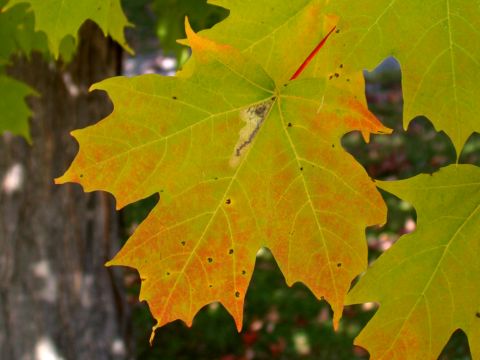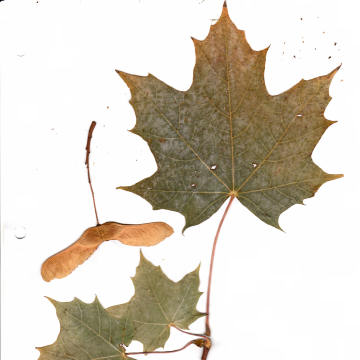

Acer saccharum - (image 1 of 9)
Taxonomy
Family: Aceraceae
Closely related to Black Maple (Acer nigrum Michx.)
Habitat
Mesic forests with a preference for rich, moist soils with good drainage.
Associates
A major component of several forest types, so associates are many.
Distribution
Southwest Ontario to eastern Quebec and south through western VA to TN, northwest through MO to MN.
Morphology
Leaves typically palmately 5-lobed; margin of lobes usually entire, sometimes sparsely toothed; upper and lower surfaces glabrous. Twigs slender, brown with pale lenticels; pith white; terminal buds reddish and pointed. Flowers yellow; imperfect; appearing with the leaves. Samaras (winged seeds) U-shaped. Bark gray, often developing deep furrows with age.
Notes
Flowers early April to mid May
Wetland Indicator: Facultative Upland
This tree is valued for it's wood, sap (for maple syrup), and ornamental characteristics. Fall color ranges from brilliant yellow to orange to red. Many states have adopted this species as their state tree, including NY. The leaf is also featured on the Canadian flag.
This species can be distinguished from the introduced Norway maple (Acer platanoides L.) by snapping off a leaf where the petiole meets the twig. If the sap is milky white it is A. platanoides. The samaras of A. platanoides are also much more divergent than A. saccharum. Other characteristics of Norway maple include narrow acute lobe teeth; fall color a clear yellow and changing about a month later than our native maples. The flowers are perfect, in terminal corymbs.

Acer platanoides
References
Dirr, Michael A.
1998. Manual of Woody Landscape Plants: Their Identification, Ornamental
Characteristics, Culture, Propagation and Uses.
5th ed. Champaign, Illiois: Stipes Publishing L.L.C.
Gleason, Henry A.
and A. Cronquist. 1991. Manual of Vascular Plants of Northeastern United States
and Adjacent Canada. Second Ed.
The New York Botanical Garden. Bronx, NY
Swink, F. and G.
Wilhelm. 1994. Plants of the Chicago Region.
Indiana Academy of Science. The Morton Arboretum. Lisle, Illinois.
|
© Michael Hough 2004 |